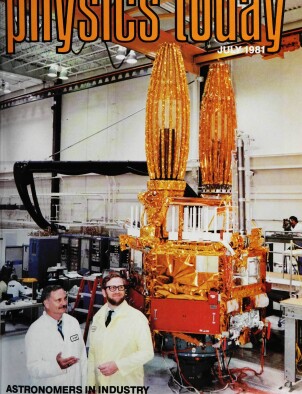The emperor’s new clothes—1981
DOI: 10.1063/1.2914645
Physicists learn early that no statement should be accepted without question. Indeed at the core of the physicist’s approach to both experimental data and theoretical structures is an insistence on asking questions, looking for patterns and checking for consistency. In this context, incorrect data, bad analysis, and overblown claims are subject to immediate challenge to prevent them from being perpetuated and making the already difficult work of understanding natural phenomena even more difficult.
This article is only available in PDF format
References
1. US Atomic Energy Commission, Reactor Safety Study: An Assessment of Accident Risks in US Commercial Nuclear Power Plants, WASH‐1400 (1974) (Draft);
US Nuclear Regulatory Commission Reactor Safety Study…, NUREG 75/104 (1975) (Final version).2. The Effects on Populations of Exposure to Low Levels of Ionizing Radiation: 1980 National Academy of Sciences, Washington (1980), gives the current status of the debate over this proportionality.
3. H. W. Lewis, R. J. Budnitz, A. W. Castleman, D. E. Dorfan, F. C. Finlaysen, R. L. Garwin, L. C. Hebel, S. M. KeenyJr., R. A. Muller, T. B. Taylor, G. F. Smoot, F. von Hippel, Rev. of Mod. Phys. 47 (1975),
Suppl. 1. See also Jan Beyea, Some Long‐Term Consequences of Hypothetical Major Releases of Radioactivity to the Atmosphere from Three Mile Island, Final Report to the President’s Council on Environmental Quality, Princeton U. Center for Energy and Environmental Studies Report ♯109 (1980).4. Oversight hearing before the Subcommittee on Energy and Environment of the US House of Representatives Committee on Interior and Insular Affairs, January 1977;
the subcommittee’s Report, Observations on the Reactor Safety Study, was published January 1977.
See also F. von Hippel, Bull. At. Sci., February 1977, page 42.5. H. W. Lewis, R. J. Budnitz, H. J. C. Kouts, W. B. Lowenstein, W. D. Rowe, F. von Hippel, F. Zachariasen, Risk Assessment Review Group Report to the US Nuclear Regulatory Commission, NRC Report NUREG/CR‐0400 (1978).
6. US Atomic Energy Commission, Proposed Environmental Statement on the Liquid Metal Fast Breeder Reactor Program, WASH‐1535 (1974).
7. H. A. Feiveson, T. B. Taylor, F. von Hippel, R. H. Williams, Bull. At. Sci., December 1976, page 10;
H. A. Feiveson, T. B. Taylor, ibid., page 14;
F. von Hippel, R. H. Williams, ibid., page 20;
H. A. Feiveson, F. von Hippel, R. H. Williams, Science 203, 330 (1979).https://doi.org/SCIEAS8. T. B. Cochran, The Liquid Metal Fast Breeder Reactor, An Environmental and Economic Critique, Johns Hopkins U.P., Baltimore (1974).
9. Edison Electric Institute, Economic‐Growth in the Future, the Growth Debate in National and Global Perspective, McGraw‐Hill, New York (1976).
10. Date for figures 4 were obtained from the following sources: EEI Pocketbook of Electric Utility Industry Statistics, Edison Electric Institute, New York (1974);
Monthly Energy Review, US Department of Energy, DOE/EIA‐0035 (81/03) (1981);
Historical Statistics of the United States: Colonial Times to 1970, US Department of Commerce (1975);
Statistical Abstract of the US, US Department of Commerce, 1975 and 1980;
Economic Indicators US Government Printing Office (January 1981).11. US Department of Energy, Energy Information Administration, Annual Report to Congress, 1978, Vol. 3 (DOE/EIA‐0173/3);
US Department of Commerce, Bureau of Economic Analysis, Survey of Current Business, October 1980.12. See, for example, Electric World, 15 September 1976, page 52.
13. T. G. Ayers, M. T. Benedict, F. L. Culler Jr, J. T. Everett III, R. V. Laney, C. Starr, C. Walske, LMFBR Program Review, US Energy Resources Development Administration (1977);
T. B. Cochran, R. E. Train, F. von Hippel, R. H. Williams, Proliferation Resistant Nuclear Power Technologies, US Energy Resources Development Administration (1977).14. “Annual Electric Industry Forecast,” Electrical World, 15 September 1977,1978, and 1980.
15. US Department of Energy, Energy Information Administration, Annual Report To Congress, 1979, Vol. 3.
16. US Department of Energy, An Assessment Report on Uranium in the United States of America Report ♯GJO‐111(80) (1980).
17. Electrical World, January 1981, page 29. See also reference 7.
18. See for example the debate in the May/June 1981 issue of Public Power magazine “Yes!” by W. B. Behnke, “No!” by F. von Hippel.
19. US‐USSR Strategic Policies, Hearing before the Subcommittee on Arms Control, International Law, and Organization of the Senate Foreign Relations Committee (sanitized transcript of a top secret hearing) 4 March 1974, page 19.
20. Briefing on Counterforce Attacks, Hearing before the Subcommittee on Arms Control, International Law and Organization of the Senate Committee On Foreign Relations (sanitized transcript of a top secret hearing) 11 September 1974, page 13.
21. S. Drell, F. von Hippel, Sci. Am., November 1976, page 27.
22. J. Wiesner, H. Brown, S. Drell, R. Garwin, S. Keeny, G. MacDonald, G. Miller, J. Neel, A. Wood, “Response of The Ad Hoc Panel on Nuclear Effects” to the Office of Technology Assessment, 25 February 1975;
reprinted in Analyses of Effects of Limited Nuclear Warfare, Committee Print prepared for the Subcommittee on Arms Control, International Organizations and Security Agreements of the Senate Foreign Relations Committee, September 1975.23. Department of Defense, “Sensitivity of Collateral Damage Calculations to Limited Nuclear War Scenarios,” 11 July 1975;
reprinted in Analyses of Effects of Limited Nuclear Warfare (reference 22).24. Hans Andersen, Fairy Tales, Schocken New York (1979).
Figure 1 is from an edition published by McKay, Philadelphia (1932).25. J. Primack, F. von Hippel, Advice and Dissent: Scientists in the Political Arena, Basic, New York (1974).
26. R. Chalk, F. von Hippel, Technol. Rev., June–July 1979, page 49.
27. P. Raven‐Hansen, Technol. Rev., May 1980, page 34.
More about the Authors
Frank von Hippel. Princeton University's Center for Energy and Environmental Studies.




